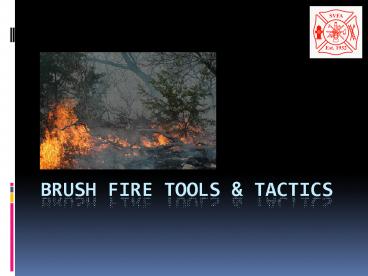Brush Fire Tools - PowerPoint PPT Presentation
1 / 15
Title:
Brush Fire Tools
Description:
All firefighters entering the woods or brush MUST have tagged in and left their ... Check all hot spots, clear and/or soak perimeter. Utilize Thermal Imager ... – PowerPoint PPT presentation
Number of Views:818
Avg rating:3.0/5.0
Title: Brush Fire Tools
1
Brush Fire Tools Tactics
2
SOP
3
SOP Details
- Clothing
- Steel toed boots, gloves, eye protection and head
protection, turnout coat recommended in cool/cold
weather NOT in summer (OIC discretion) - Vehicles
- Brush 3 and Tanker will position in vicinity of
brush (upwind if possible) and maintain a means
for egress should conditions deteriorate. All
other units stage until given assignments. E4
CAFs or Gator at OIC discretion.
4
- Accountability
- NEVER enter wooded areas alone or without
notifying an Officer or Engineer. - All firefighters entering the woods or brush MUST
have tagged in and left their Accountability ID
tags with lead Engine/Command post! PARs will be
conducted every 25 minutes.
5
- Overhaul
- Check all hot spots, clear and/or soak perimeter.
Utilize Thermal Imager (TIC) as appropriate. - Precautions
- Watch for, and avoid heat exhaustion with proper
hydration. - Be aware of wind direction and velocity
- Be aware of direction fire is traveling to avoid
getting stranded. - Be careful in rough terrain.
6
- Tactics Strategy
- Brush fires may present a large area of rapidly
spreading fire. The critical decision is where to
attack the fire - The basic brush fire philosophy is to
aggressively stop the forward progress of fire
whenever possible. Protection of exposures is the
primary goal when immediate control is not
possible. - Command must be prepared to readjust and develop
a defensive strategy to protect exposures while
allowing the fire to burn to a location better
suited for control.
7
- Tactics Strategy (cont.)
- When water is in short supply, it is usually most
effective when applied to burning material
instead of wetting fuel in advance - The following is a list of size-up considerations
that greatly affect tactics and strategy - Location of fire head or heads-- The fast moving
part of the fire - Pertinent burning conditions--weather, time of
day, etc. - Type of fuel--light, heavy fuel
- Exposures--improvements, buildings, crops, etc.
- Size of fire and rate of speed
- Line of retreat
- Power Lines!
8
- Method of Attack
- Operations Officer will make decisions relative
to hand lines, attack direction, teams, etc. - Two Teams will advance on the Left and Right
Flank of the fire. Teams will work towards the
head or point to cut off fire advancement. - Each team should consist of 5 firefighters
utilizing 2 brooms, 1 Indian Tank, and 2
utensils (axes, brush hooks, shovels) - If a hose Line is advanced, all firefighters
assist in positioning hose. - OIC has discretion to utilize CAFs provided
Engine 4 can achieve an appropriate position with
means for egress should conditions deteriorate.
9
Fire Attack
- Two Teams will advance on Left and Right Flank of
the fire. Teams will work towards the head or
point to cut off fire advancement. - The head of a small brush fire can be approached
safely from either the burned-out blackened area
or from the flanks of the fire. - Positioning firefighters on a road or
firebreak area in front of fast-moving brush
fire can be extremely dangerous
10
Fire Attack
11
Tools Brush Broom
- Sweep embers and fuel into burn area
- Start the sweep at least 1 foot into unburned
area - If suddenly working alone, be alert and use
effective communications.
12
Tools Brush Hook (aka Fire Rake)
- Scrape down to dirt
- Cut through roots
- Create a control line
13
Tools Indian Tank
- Backpack design
- 5 gallons typical
- Filled by B3, Gator
- Manual Operation
14
1. Heat Exhaustion
- Those most prone to heat exhaustion are elderly
people, people with high blood pressure, and
people working or exercising in a hot
environment. - Warning signs of heat exhaustion include
- heavy sweating paleness
- Muscle cramps tiredness
- Dizziness headache
- Nausea/vomiting fainting
- The skin may be cool and moist. The victim's
pulse rate will be fast and weak, and breathing
will be fast and shallow.
2. Heat Stroke -gtfatal
15
- Questions?































